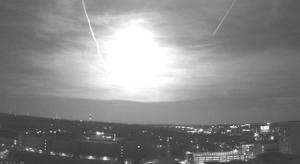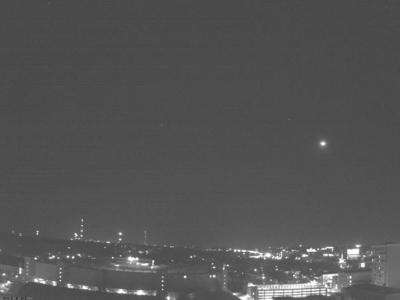Wisconsin Fireball Caught On Tape

(PhysOrg.com) -- A rooftop webcam at the University of Wisconsin-Madison captured the final seconds of a fireball's Wednesday, April 14 descent into the atmosphere. A fireball is a meteor, or "shooting star," that emits a brilliant light as it enters Earth's atmosphere.
News reports in the area indicated that 911 call centers in at least six states began to light up with calls reporting the celestial visitor a little after 10 p.m. local time. Eyewitness accounts stated it was moving from west to east and broke into multiple pieces. Numerous witnesses also heard crackling sounds and a sonic boom. It is not know yet if any debris from the fireball survived the intense heat of atmospheric entry and made it to Earth's surface.
"The frequency of space debris entering our atmosphere that is large enough to generate a fireball is something on the order of once or twice a day," said Don Yeomans of NASA's Near-Earth Object Office at the Jet Propulsion Laboratory in Pasadena, Calif. "What is somewhat unique about this one is that it was witnessed by so many and captured on tape. Sounds like it was spectacular. I wish I had been there to see it, too."
Data collected by scientists at NASA's Marshall's Space Flight Center, Huntsville, Ala., indicate the parent body of the fireball was approximately 1 meter (3.3 feet) in length and was not associated with the Gamma Virginids meteor shower, which was taking place at the time the fireball entered the atmosphere. Instead, the small space rock more than likely originated from somewhere in the asteroid belt.
When the fireball disintegrated high in the atmosphere, it released energy equivalent to the detonation of approximately 20 tons of TNT.

"Knowing the size of this small asteroid helps us determine the frequency of such occurrences," said Yeomans. "Asteroids this size are expected to enter Earth's atmosphere about once a month."
NASA detects, tracks and characterizes asteroids and comets passing close to Earth using both ground- and space-based telescopes. The Near-Earth Object Observations Program, commonly called "Spaceguard," discovers these objects, characterizes a subset of them, and plots their orbits to determine if any could be potentially hazardous to our planet.
Provided by JPL/NASA





















